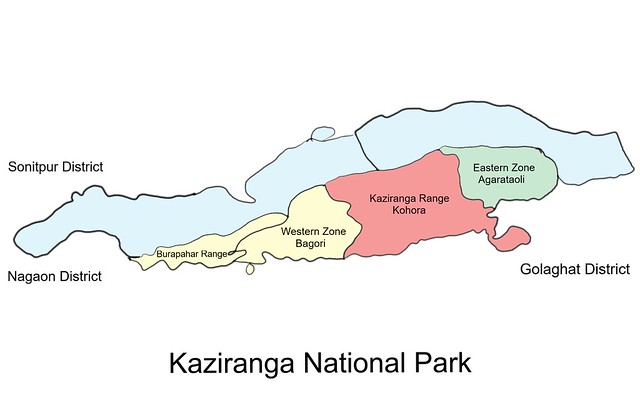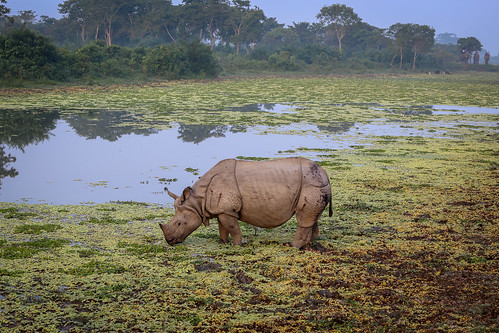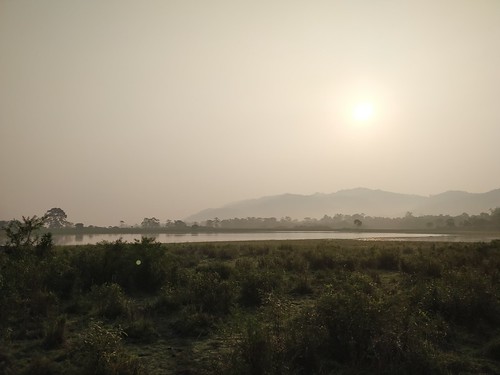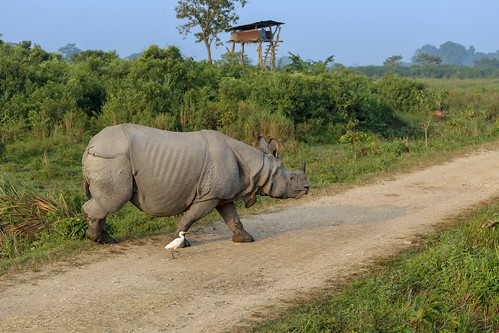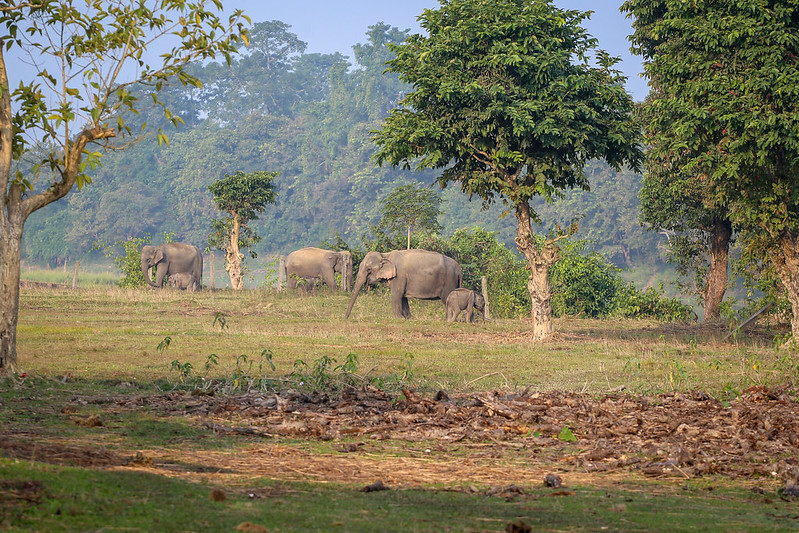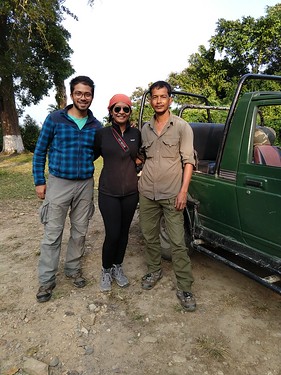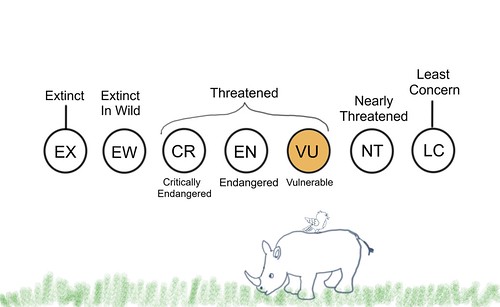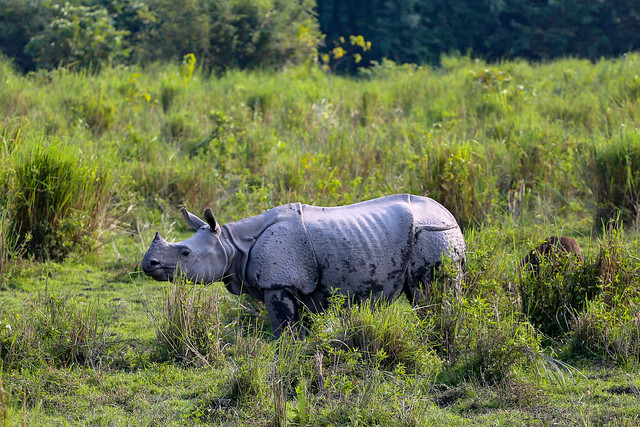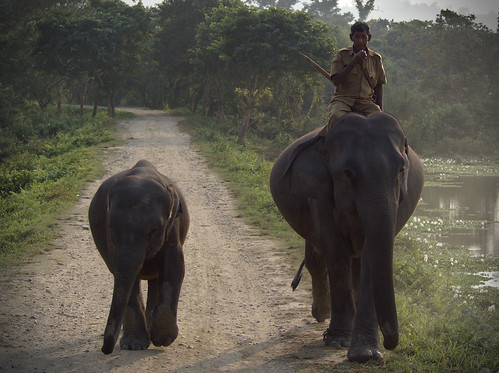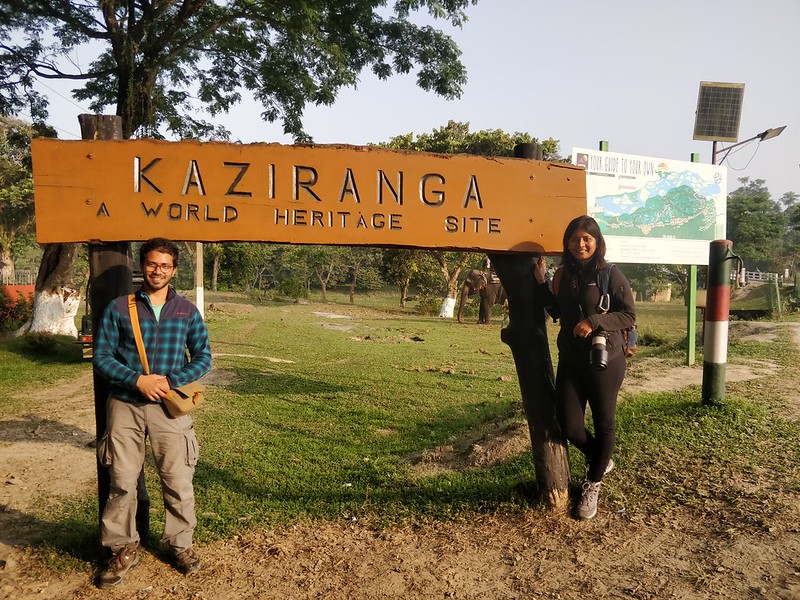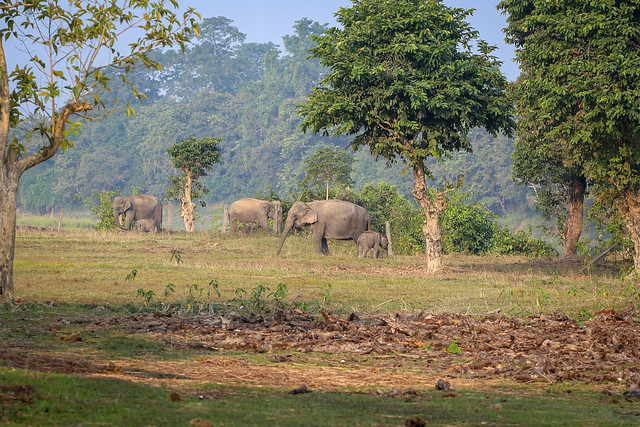Kaziranga National Park had been on my list for as long as I can remember. I always wanted to see the Greater Indian one-horned Rhinos. It was ideally supposed to be right after Ziro but due to rains the National park was closed. We made a trip to Kaziranga by the end of November, not long after the opening of the park. Besides being able to visit the park the other excitement was to be back on our bikes. For me it had been a long break since I did Meghalaya in a car before I went home for Diwali. For Karan the break was shorter but it was good to be back on our monsters ❤️.
Loaded with recommendations we left for the national park leaving the comfort and delicious food of my aunt’s house yet another time, it was slowly becoming a base for us in the north east.
Wait, is that a Rhino?
Ruma mausi had recommended Bhuban as one of the best guides to go around with while in Kaziranga. Night before our departure, I spent time planning our time at Kaziranga with Bhuban. We left Guwahati rather late. Well, later than what we usually do. We found relatively good roads for Assam standards, very good in fact 😛. It was a short ride, only 3.5 hours and soon we entered the National Park territory. Lush green trees flanked the roads and we could see warning signs for animal corridors, elephant and rhino crossing. I had started to appreciate the vibes of this national park, there is something about national parks that makes me very happy and Kaziranga had a very loveable National Park feeling to it.
The Kaziranga animal corridor is a part of the highway that leads to Dibrugarh. Sadly, commuters forget that the highway is also an animal corridor and despite there being a countless speed limit warnings of 40kmph no one really paid any attention to it. Almost everybody zoomed past us. There weren’t any speed checks as well even when the boards screamed of heavy fines. I guess it is only when you do not have something you realize it’s worth, or maybe it’s more like who cares about the animals?
We were just discussing this when we saw something in the grassland from the highway. It was a bit far but once we halted it was clear. It took us a while to believe it because well, we were on a highway. The reaction was something like “Wait, What!!!”. It was a RHINO! OMG! We had barely entered the park and we spotted our first Greater Indian Rhinoceros ❤️
Safari Zones of Kaziranga
Kaziranga National park is known for being the habitat for the big 5 : One Horned Rhinoceros, Asian Elephant, Royal Bengal Tigers, Wild Buffalos and Swamp Deer. The national park is divided into four safari zones:
- Central Zone (Kaziranga Zone) - Have both Elephant and Gypsy Safaris.
- Eastern Zone (Agarataoli Zone) - Have Gypsy and Boat safari, good for birding.
- Western Zone (Bagori Zone) - Have both Elephant and Gypsy Safaris.
- Burapahar Zone - Gypsy safari as well as a trekking route. Best zone for Birding.
For all of the above activities one needs to obtain a permit for the Gypsy and/or the Elephant. The following fee/permits may be needed:
- A day pass to enter the park, which can be used multiple times in a day.
- A fee for the cameras depending upon the type(Still, Video, Professional Videography).
- A Fee for the guide is included in the Gypsy/elephant fare
- A tip at the end of the safari for the guide is a good gesture(it is also expected).
Do note, no private vehicles are allowed in the park. The place you are staying with will most probably hook you up with someone who will complete all these formalities.
The Foreign Bias
Our first stop was the Central range to check the scene of the elephant safaris since Bhuban had mentioned it’s not easy to book this one. Lo and Behold, the line for a morning elephant safaris in the Central Range started a day before, at 4PM and the ticket counter for which opened at 7PM.
Next catch, the tickets were sold on a first come first serve basis and if the tickets are sold out by the time your turn comes you will not get it for the next available slot.
Final catch, the first preference at the central range was for Foreign tourists and VIPs. Gypsy safaris were available anytime though.
On expressing our displeasure on the same we were told to go to the Western Range where booking an elephant safari is easier. This was utterly annoying. I guess a better model would be to have higher charges for the Central Range(as foreigners are charged more) and then let tourists decide if they want to pay for it or go to any of the other ranges.
Settling In
More about Bhuban, he was recommended to us by my aunt, Ruma mausi. He is a very knowledgeable guide and having worked as an assistant to a BBC film makers he was a kick ass photographer too. He had recommended that we reach the Central Range and look for accommodation in Banashree Tourist Lodge. Surprisingly, it was full. He had also searched for a few other options for us. We came out to look for places and after my hangry episode we decided it was best to have lunch first 😛. Post lunch we finalised our stay at Home Staytion, a newly built homestay on the highway.
Bhuban came to meet us in the evening. He seemed like a fine chap. We planned our safaris over some tea and pedas. Apparently the central range has Government authorised elephants for safaris while the Western ones are operated privately. Off late the number of elephants had been reduced hence the availability was a problem. Bhuban suggested against the Central range as the grasslands were way too tall and would interrupt the sightings and the photography. The Eastern range was better for birds and the migration season had barely started so that was not advised as well. Western range it was.
A few phone calls were made by Bhuban to see if a morning Elephant safari was possible. It was and we were all set for the 5:30 AM safari in the morning. He told us to take the elephant safari and then decide if we wanted to do the Gypsy safari. We agreed but we were going to do the Gypsy safari anyway 😁
Safari on the Original 4X4
We woke up at 4:30 AM. The Western range was a good 30 mins away from our homestay. We left at 5 AM sharp only to wait at the permit gate till 6 AM. As we made our way to the elephants, we were asked to stop as a Rhino was crossing through the jungle 😂. This had got to be the best crossing ever. We were not even ready to click this. We boarded our 40 year old elephant Kanchan along with an elderly couple from Jabalpur and started at around 6:15 AM. We were asked to maintain silence and try to sit at a fixed angle to help Kanchan manage our weights, which we were failing at miserably. The elephants were divided in groups of 5-6 and each group took a different path.
We had barely covered 100m when we spotted another Rhino. Now, the challenging part about an elephant safari is camera stability. If the elephant is moving it is really hard to get a clear picture 😂. Usually the mahaut(elephant rider) stops for the customers to take a picture, after all his tip depends on the sightings, but for this one ours wasn’t convinced that we should make a stop and he moved on. Then without a warning the elephant left the well paved path towards marshy lands. Ofcourse! Elephants are the original 4X4. We had barely gotten over this excitement from Kanchan’s maneuvering when we spotted the next Rhino, up close. Very close. This I guess is the biggest advantage of an Elephant safari. Elephants can go really close and Rhino doesn’t seem to mind them. This Rhino was beautiful with a perfect backdrop. We were awestruck and so much in love with these creatures. Moving on we saw another bunch of Rhinos grazing nonchalantly.
Kanchan moved without any rush in the world and gave me a lot of time to admire the beauty around. This leisurely walk of the elephants forces one to appreciate things at a different pace. While we were on Kanchan the tall grass touched our feet; even when we were atop a full grown elephant. When I looked down to check what was touching my feet I realised how high up we were. The elephants would occasionally pull out this grass and start grazing much to the displeasure of the mahauts 😛.
We progressed at an enjoyable pace to the Dighali Beel(lake-like wetland). We could see a few birds here, the lady from Jabalpur was kind enough to lend her binoculars to us to see some of the birds. We also saw Rhinos grazing across the beel. It had been 40 mins since started and it was time to head back.
We had just reached the paved path when we saw another greater one approaching. The elephant stopped and we saw the one-horned beauty cross the road in style with a sidekick. There are no words that can describe that feeling, maybe the following visual will help.
We had barely turned our heads after bidding goodbye to this Rhino when we saw a giant wild buffalo staring at us. It must be looking at us the same way we see them “What are these creatures?” 😝. We were back in about 50 mins from when we started; way more happy than what we had imagined but not yet content. We tipped our mahaut and said bye to Kanchan. On our way out we saw a three mother elephants with their kids grazing along the river ❤️.
For sure we were coming back in a Gypsy. We had just said this when we met Bhuban who was taking a group of tourists for a safari. We told him how we had loved the elephant safari and fixed a time for later that day for our Gypsy safari. We left back for the homestay, had some food and slept.
Safari with Bhuban
We were dead asleep when the alarm rang. Bhuban arrived by the time we got ready. It was just going to be the three of us. Bhuban educated us about the success story of the Rhino conservation in India. How a British lady started the move on seeing pugmarks, the political scene around poaching in times of Congress and how the Rhinos are not endangered anymore.
The Story of Conservation
It was year 1904 when Baroness Mary Victoria Leiter Curzon, wife of Lord Curzon, the Viceroy of India visited Kaziranga to see the Rhinos. Upon her numerous visit’s she couldn’t see any Rhinos but only some hoof marks. Impressed by famous animal tracker Balaram Hazarika, she asked her husband to take necessary actions to preserve Rhinos and hence the reserve of Kaziranga was created in 1904.
Thereafter more land was added to the reserve and the park was officially closed for shooting in year 1926. It opened up to visitors in 1938 again and after Independence it was declared a Wildlife Sanctuary in 1950. In 1974 the area was declared a national park and was acknowledged as a UNESCO World Heritage site in 1985. As of today The Greater Indian Rhinos are no longer Endangered. As per IUCN(International Union for Conservation of Nature) list version 3.1 they are Vulnerable, which still comes in the category of Threatened.
Sightings from the Gypsy
A Gypsy lets you see the Rhinos from afar, it does not have the intimacy of the elephant safaris. But a Gypsy safari can go deeper into the forest and usually lasts for around 3-4 hours. We started by going towards the Dunga Camp view point. The arrangement in the gypsy was like this, Bhuban in the driver’s seat, me in the center row and Karan in the last one. Bhuban told us how Rhinos love to eat the fresh grass in the wetlands and hence we usually see them standing in marshy areas chewing. Somewhere in my heart I was praying to see a tiger 🐯. I also told Bhuban I wanted to see a baby Rhino and he said there are a few in the park. The moment we crossed the tall trees to the grasslands we saw Rhinos on either side of the road ❤️. We also joked that every Rhino has an entourage of birds and some bigger celebrities may also have a deer with them 😝.
We reached the view point. The base of the building had water level readings of flood corresponding to the year it happened. From the top of the view point we could see the Dighali Beel again and oh SO MANY rhinos and buffaloes and deer and numerous birds. Karan and I have a telephoto lens each, which we thought was good till we stated shooting the birds at Kaziranga 😛. Here are the pictures that led to the conclusion that we need better lenses 💰.
After basking our eyes in the views from the top of the building we were back in the Gypsy ready to move on. On our way back we saw another rhino fresh from the bath and a few deer as well. Bhuban mentioned that the color after the bath is the actual color of the Rhino and not the grey one which we usually see. A domestic mother elephant and her baby stopped our Gypsy midway. The baby elephant wanted to touch the car and Bhuban seemed to know the drill. I cannot even explain how the baby elephant melted our hearts. We waited for the baby to have it’s full and give us way. Once we were off again Bhuban called out excited. Far off we could see a Rhino and it’s BABY!!!!! Wooohoooo!!! Bhuban was as happy as I was 😄.
We used to halt and wait silently at all the popular animal crossing points, hoping for a sighting, Rhino realistically and a tiger optimistically 😛. We went till the edge of the permissible limit of forest (for tourists) and waited there as well. It was apparently a famous tiger crossing area. Bhuban was trying really hard for us 😊. We stopped at a couple of more places one for the sunset at the beel and another place for a possible tiger sighting. Eventually after 4 hours of safari time we headed out of the park(unfortunately without spotting any tiger).
It was almost dark by the time we reached back to our homestay. We thanked Bhuban for telling us all about Kaziranga and the wonderful Rhino stories. Happy and finally content with the events of the day we started packing up for our departure the next day ☺️
Here is a complete album from our time in Kaziranga National Park. Pictures are credited to Karan and me.


